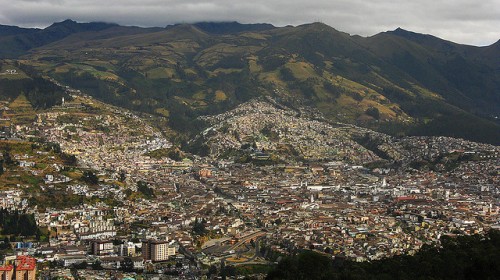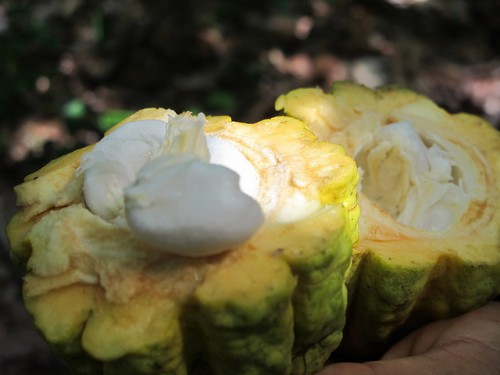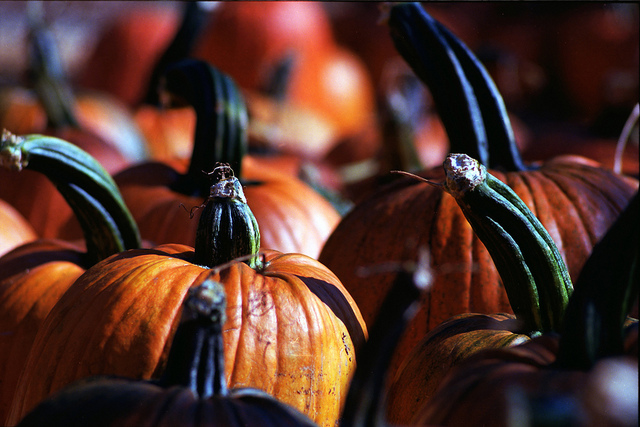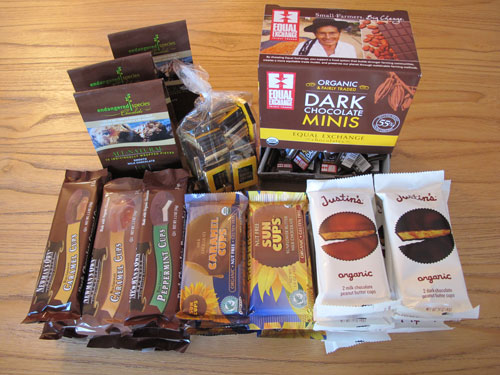In Defense of White Chocolate, by Jennifer Doody

white chocolate bar by chotda
The world of chocolate is one sharply divided by hierarchies of cocoa content. I must solemnly confess that I have long harbored a prejudice against white chocolate and, by extension, consumers of white chocolate. Perhaps this distaste developed in response to the cloyingly sweet white chocolate Easter confections of my youth, or as a natural extension of a passion for dark chocolate. Why sully such perfection by removing cocoa content? However, when author Jennifer Doody told me — at our first face-to-face meeting, while she sipped on a white hot chocolate (gasp!) — that she was a fan of the ivory colored stuff, I was first shocked and dismayed, then deeply fascinated. Please teach me more about your kind, I implored! Her response is below.
And I ask you, fellow lovers of chocolate, what do you think?
——————————————————————————————————————————
In Defense of White Chocolate, by Jennifer Doody
Several years ago, a close friend and I were musing about one of our favorite things.
“What type of chocolate do you like best?” she asked warmly.
I didn’t hesitate. “White chocolate, definitely,” I said.
She stared at me in disbelief and then uttered a sentence I’ve heard many times since.
“That’s not chocolate,” she huffed.
I was taken aback. Of course it was chocolate: it said so on the bar! But alas, no amount of marketing citations or arguments would sway my friend. The fact that white chocolate contains cocoa butter, but not cocoa solids, was irrefutable evidence against white chocolate’s inclusion in the world of Real, Actual Chocolate.
Ever since that exchange, I have had to come to a brutal realization. Despite my love of the German chocolate of my youth, I simply am not a cocoa snob.
That’s not to say that I don’t appreciate fine chocolate. I do. But when friends discuss the eloquence of cacao nibs, wax rhapsodically over a newly discovered delicacy with an enormously high cocoa content, or rave about semisweet, bittersweet, or super dark chocolate… my eyes glaze over. Just the tiniest bit, mind you. But enough for me to know, deep down in my bones, that I’m afraid of being found out; I fear that my love for the sweet, creamy texture of white chocolate will render me an outcast among my fellow chocoholic friends.
So what is at the center of the controversy? How can such a sweet, ivory treat generate such division among friends? For those opposed to white chocolate, it primarily has to do with how the composition and creation of white chocolate differs from that of other chocolates.
HowStuffWorks provides a clear, layperson’s explanation of the chocolate production process. In a nutshell, cacao nibs are separated from the shells of roasted cacao beans, and then ground into a brown paste called cocoa mass. Cocoa mass is then heated and melted to become chocolate liquor – a slight misnomer, as the liquor is not alcoholic.
Here’s where it gets interesting, because one of two things can be done with chocolate liquor. First, it can be molded and cooled into hardened blocks. This process results in unsweetened chocolate, which most of us know as unsweetened baking chocolate. Chocolate liquor alone can be quite bitter tasting, so chocolate makers often combine it with a variety of delicious products, such as sugar, powdered dairy, vanilla, or other flavors.
Another option for chocolate liquor, however, is to “press it in a hydraulic press to squeeze out the fat. When you do that, what you are left with is a dry cake of the ground cocoa bean solids and cocoa butter.” Cocoa solids go on to become what we know as cocoa powder. It is the latter product, the cocoa butter, the fat of the cacao bean, which goes into white chocolate.
Cocoa butter is a rather magical substance. Renowned for its stability and texture, it possesses natural antioxidants, which help maintain its storage life for multiple years. Its luxurious feel, mild chocolate fragrance, and emollient properties make it a popular ingredient in cosmetic products, including skin creams, soaps, and makeup. Because it is nontoxic and melts at body temperature, it is also used in the pharmaceutical industry as an ingredient in suppositories and oral medications.
For our purposes, however, cocoa butter plays a crucial role in the making of white chocolate. White chocolate makers combine cocoa butter, a sweetener – usually sugar, though other sweeteners are increasingly common – as well as powdered dairy or a nondairy alternative, and vanilla. Various other ingredients can also be added, such as fruits, nuts, or herbs.
(Unfortunately, not all white chocolate is created equal. Some manufacturers add hydrogenated vegetable oils or animal fats in place of cocoa butter in addition to less desirable sweeteners and preservatives. If you are a white chocolate lover, it’s possible that the white chocolate you’re consuming possesses no cocoa butter whatsoever. Read the ingredients list of any product that you consider buying to be sure that you are getting white chocolate instead of a mock white chocolate confectionery product.)
To better regulate the industry, in 2002, the U.S. Food and Drug Administration (FDA) declared that white chocolate must contain “a minimum of 20% cocoa butter, a minimum of 15% of total milk solids, a minimum of 3.5% milk fat, and a maximum of 55% nutritive carbohydrate sweeteners.” By contrast, milk chocolate, sweet chocolate and semisweet/dark chocolate must contain no less than 10%, 15% and 35% chocolate liquor, respectively. (This is in addition to the cocoa butter that chocolate makers add to these types of chocolate.)
So for those opposed to white chocolate, much of their argument relies on the fact that white chocolate does not contain cocoa solids. But do not milk and dark chocolate possess the cocoa butter that gives white chocolate its creamy, velvety texture? Is milk or dark chocolate rendered any less divine because it contains the controversial cocoa butter ingredient? As a fellow white chocolate aficionado insists, “Isn’t it all chocolate?”
Purists and nibs connoisseurs will cry foul. Nay, they will proclaim, only the almighty cocoa solids can bestow the glorious title of chocolate upon a product! The bitterness of dark chocolate only further affirms me as a chocolate fanatic! My zeal for the meat of the cocoa bean cannot be undermined or besmirched! And to those fine, passionate people – many of them dear friends of mine – I can only nod and say, of course. As you will. Carry on.
It just means there’s more of my beloved white chocolate for me.
——————————————————————————————————————————
Jennifer Doody is a writer with 20 years experience in university news, communications, and academic editing, based in Boston, Massachusetts. Visit her professional site here to read more of her work.
Bittersweet Notes Guest Blogs a Review of Daniel Jaffee’s Brewing Justice
Chocolatier and chocolate advocate Jeffrey G. Stern invited me to guest post on his professional chocolate blog. An excerpt from the post, a review of Daniel Jaffee’s 2007 book, Brewing Justice: Fair Trade Coffee, Sustainability, and Survival, is below with a link to the full content. The book is of great value to those interested in the impacts of alternative trade models on farmers’ lives. Enjoy!
————————————————————————————————————————-
There are striking similarities between the worlds of coffee and cacao — think ecology, production, health, history, and culture. More recently, coffee and chocolate have been brought together as two of the most commonly available fair trade certified products. However, the ethical or cause based market is more developed in the coffee world. This is likely due to the worldwide popularity of coffee consumption and the relative transparency of the coffee making process (consumers often deal directly with the beans themselves). Because of the plethora of alternative trade models to be found in the coffee world, I have, in my research on the ethics of chocolate, frequently turned to the work of coffee experts for guidance and inspiration.
Ethical sourcing of goods cultivated only outside the United States is a challenge fraught with unequal power relations and market shares. For those who support the development of more equitable trading practices, a turn to fairly traded products is often desirable. The question remains, though, as to how much of a difference (if any) fair trade certification makes in the lives of the individual farmers cultivating our beloved beans.
Daniel Jaffee set out to answer this very question in his excellent book, Brewing Justice: Fair Trade Coffee, Sustainability, and Survival. The book offers a supportive yet critical account of the global fair trade system and its local effects on the lives of coffee growers in Oaxaca, Mexico.
To read the full post, visit Jeffrey G. Stern’s blog here.
Interview with Jeffrey Stern, Chocolatier and Chocolate Advocate in Quito, Ecuador, continued

Quito, Ecuador by Orban López Cruz
Jeffrey Stern is a chocolatier, chocolate advocate, entrepreneur, and blogger based in Quito, Ecuador. I recently asked Jeff to answer a long list of questions about his life and work, and he was kind enough to oblige. The first part of the interview can be read here. Below, in the second part of the interview, Jeff presents his views on standards in production, trade certifications, power relations, communication, and sharing in the chocolate world.

Fresh cacao by Mikko Koponen
Interview with Jeffrey Stern, Part 2, November 2011
Carla Martin (CDM): What standards in chocolate production do you value?
Jeffrey Stern (JM): I guess I’d have to say transparency over all. I’ll have to speak specifically to my situation in Ecuador on this first. I would love to be able to buy all chocolate made from pure Nacional beans for my production, but for both financial reasons and reasons of control, I can’t.
First off, the market here won’t bear a high cost chocolate. For example, I could buy Kallari couverture for all my chocolate making, but at $16 per kilo I’d lose money on everything I make. I just can’t pay that much for chocolate and be able to make money on it here. Unfortunately, we all have to eat.
Second, as I have discussed frequently, I can’t control what the local manufacturers’ choice of beans is and so I can’t know what beans they are using when they make chocolate. I wish I had large enough volume to have custom batches of chocolate made for my own use, but I don’t. So for local production, I buy some couverture at around $6 per kilo. If I had the volume, I’d source beans myself and have the chocolate made per my own specs. But what I buy at the lower end of the price scale is most likely mixed beans (CCN-51 and Nacional).
I do buy some pure Nacional couverture. How do I know it’s pure Nacional? I have a friend who is part owner in two large farms of pure Nacional cacao. I have been to the farms and seen them. He is Swiss, has lived here 30 years, I’ve been doing business with him nearly since I arrived five years ago, and I trust him. He has couverture made in country and sells it to me, among other people, at a fair price.
What’s important to me is to be able to know something, preferably a whole lot, about where my chocolate comes from, how it’s been produced, and what’s in it. I think the links most chocolate manufacturers state they have with the sources of their beans are tenuous at best most of the time, and certifications don’t really interest me as I don’t think they say much. It’s a paradox, but I would say the smaller, artisan chocolatiers are at both an advantage and disadvantage to the big guys. The big buyers can buy a whole farm or cooperative’s production and make a chocolate out of it and call it “Single Estate,” though that doesn’t mean it might not be mixed with other beans. But if they can’t get enough beans from one prime source, they are forced to blend. Economy of scale works both to their advantage and disadvantage. The small, artisan chocolatier can buy beans from just one or two or three prime sources, and can make a different batch of chocolate from each of those sources, which the big players can’t do because of scale problems.
I am not so much concerned with organic, Fair Trade, Rainforest Alliance, or other certifications. Here in Ecuador, to buy chocolate with any kind of certification is unfeasible price-wise for the local market. I think this is an interesting rhetorical question for consumers in the developed world to consider, too — “I can buy this ‘certified’ chocolate in the US, and yet there’s no market for it in the country of origin?” Right there is a topic to ponder.
CDM: How do you aim to share your knowledge about chocolate with others?
JS: I spend a lot of time online trying to blog, advocate, and discuss the issues facing Ecuadorian cacao, as well as many of the technical aspects of chocolate making, confectionery, etc. I don’t really focus on a global level as I don’t consider myself an expert on cacao worldwide — nor on cacao in general. But blogging only gets me so far and to a limited audience. I am hoping to get some video content online as well soon.
Fortunately, after four long and difficult years getting established in Ecuador and building a reputation as a person knowledgeable about chocolate and the industry here, I have been recognized and sought after by local businesses, especially in the travel and tourism area, and internationally. It’s unfortunate that I have to look mainly outside of Ecuador for interest in the ideas I have to share, but again, one has to make a living. I now have offerings with three different tour operators — I’ll be the guide for a four day portion of an eight day tour in February and March of 2012 with Ecuador Jungle Chocolate. The first four days will include visits to chocolate makers in Ecuador, and the second four will be focused on mushrooms with Larry Evans. I am also working with Quasar Nautica and Gentian Trails; we will have offerings of chocolate classes for tour groups, as well as tastings and visits to chocolate factories in Quito. I’ll also be meeting with and helping Sharon Lane as part of a documentary effort about chocolate in Ecuador in December 2011.
CDM: How do you communicate with other chocolate makers and chocolatiers?
JS: Most of the people I know in the chocolate community are extremely open and helpful. I use The Chocolate Life for some communication and information sharing and to help share some of my ideas. But I find my most valuable contacts are direct. Two years ago I had the opportunity to meet with Michael Recchiuti in San Francisco and spent a long Sunday morning with him, asking questions and sharing my experiences in Ecuador. Since then I’ve been fortunate enough to be able to email with him directly on many ocassions. I’ve also reached out to Christopher Elbow in Kansas City and he’s been very helpful. When I visit the US, which is almost every year, I try to take a class or two. Last year I took a class with Patrick Peeters, the head R&D Chef Chocolatier for North America at Godiva. Linkedin is also a great resource. I have been reaching out, expanding, and intensifying my efforts to stay connected with people in the US; even though I may be located in the “center” of the chocolate world in some ways, I often feel very much at the periphery of what’s going on in the world, because, let’s face it, the developed world where the money is drives the trends and shapes what happens with chocolate much more than the producers of cacao do.
I’ve also been extremely fortunate in working with Dana Brewster and Mark DelVecchio of Millcreek Cacao Roasters. They initially came to Ecuador to source cacao, hiring me as their guide. Since then, we’ve developed an excellent working relationship and we are working together on a Kickstarter project to be launched soon.
CDM: How do you understand your role or place in the chocolate world?
JS: My job as a chocolatier I wouldn’t replace for anything. While it’s totally unofficial, because chocolate is universally appreciated, I see myself as sort of an “Ambassador” for Ecuadorian chocolate and the issues surrounding it. Of course, many of the issues facing Ecuadorian cacao growers and the chocolate industry here have similar parallels elsewhere.
This summer I was at a cacao trader’s patio in El Empalme, Ecuador. He obviously moved large quantities of not only cacao, but also rice, coffee, and corn. I asked him if he exported and I was taken aback when he said no; he said he didn’t have the language ability nor the contacts to export. I think there are something like 36 official cacao exporters in Ecuador. Most of them don’t tell anyone much about what they’re doing, their business, or the issues involved. Maybe they’re too busy, they don’t want to, or they’re just not interested. There are also many cooperatives or producers’ associations in Ecuador — some do better than others at getting their stories out there. But in general, the small producer/cooperative/association is pretty much unknown. I would like to be able to remove the veil that covers the cacao trade at the ground level; too much of the business is controlled, both in economic terms and in “story” terms, by the big players and large markets.
I would love to see the day when consumers, through their pocketbooks, have influenced the other end of the cacao chain, especially the buyers, to pay a premium for pure Nacional cacao from Ecuador. A level playing field where Nacional is awarded a premium for its flavor profile and thus is once again more widely grown, despite its lower productivity and lower disease resistance than CCN-51, would be a boon for chocolate connoisseurs worldwide. It would be an amazing day if chocolate lovers worldwide would rise up in outrage like they recently have against Bank of America’s $5 debit card fees or Netflix’s plan changes! Sure, it’s not an exact parallel because these examples are about price hikes consumer don’t want; but if consumers were to respond in a similar fashion about price hikes they think farmers should get for their goods, well, this would be a radical shift in thinking.
CDM: How has travel and living abroad affected your appreciation and understanding of chocolate?
JS: I could never have learned all I know about Ecuadorian cacao and the industry here without having lived here for several years. I would never be able to understand the flavor nuances in chocolate without having tasted chocolate liquors from different farms. Now that I understand just how remote the source of much of the world’s great cacao is, it’s really amazing how it arrives all the way to your store or postbox. It arrives with such ease, and yet there is still such a large disconnect, and in academic speak, market fragmentation, on the ground here in Ecuador. The market mechanisms are broken and connections between cacao producers, cacao traders on the ground here, and cacao exporters are unregulated, unstandardized, and inefficient. This means that most of the time, small producers don’t get a fair price for their cacao, quality is not awarded the premiums it should get, and rare, fine aroma cacao doesn’t get the respect and treatment it deserves.
CDM: Is your fluency in Spanish important to your work?
JS: Without Spanish, which I learned by the way as an AFS Exchange Student to Chile in 1986, I would not be where I am today. Knowing Spanish allows me to communicate directly with everyone I work with, gives me additional business opportunities, and just opens an infinite number of doors to me as both an individual and a business person that weren’t even visible before. I of course use Spanish everyday, and it has allowed me to teach, share, and attract opportunities.
——————————————————————————————————————————–
Visit Jeffrey Stern’s blog here to learn more about his adventures with chocolate just south of the equator, and follow his company Gianduja Chocolate on his website and on Facebook. Also, stay tuned for Part 3 of this interview, as well as further details on Jeff’s upcoming Kickstarter campaign — he is currently working to launch a direct trade project to promote Ecuador’s heritage Nacional cacao and benefit small farmers.
Bittersweet Notes and The Root: Chocolate’s Bittersweet Legacy

Halloween pumpkins at the field by DeusXFlorida
This morning, The Root published a piece I wrote entitled Chocolate’s Bittersweet Legacy. In the article, I detail labor abuses in West African cacao cultivation, the chocolate industry’s decades long inaction on the problem, and recommended responses for consumers who want to make a difference. I hope that you’ll check it out.
Two related posts on my blog are:
- Ethical Halloween Candy 2011, which offers a comprehensive list of fairly traded alternative Halloween chocolate candies with recommendations on where to buy and price comparisons, and
- Ethical Halloween Candy 2011 Taste Test Results, which details the results of a taste test survey of many of these fairly traded candies.
If you’re not familiar with The Root, I also recommend browsing through some of the other articles and blogs when you visit the site. It’s a leading source of online news and commentary from an African American perspective and one of my regular reads.
Happy Halloween!
Ethical Halloween Candy 2011 Taste Test Results

Trick or Treat! by Jason Paluck
A few weeks ago, I posted a long list of ethical Halloween chocolate candy alternatives. Because these alternative candies are unfamiliar to many, I sent samples out to a small army of kid and adult taste testers to ask their opinions. My goals were to get a sense for how kids and adults react to candy that is new and different and to see if they would even like these lesser known ethical alternatives.
In short, there’s good news. Our tasters ranked several fairly traded alternative candies superior to traditionally popular brands lacking ethical sourcing. Some concerns were raised about availability, package design, candy size, and price points, but the results of this taste test were largely successful.
The totally-unscientific-yet-super-delicious survey design went something like this:
I sent the survey out to 8 families, 24 people total. Each family received 5-6 types of candy to try. I asked each person in the family to rate each candy as “Yummy,” “OK,” or “Gross.” I also included a few questions:
- “How does this candy compare to other peanut butter cups/milk chocolate squares/peppermint patties that you’ve had?”
- “Do you like the packaging?”
- “Is the candy too big or too small for Halloween?”
- “What is your favorite candy that you tried today?”
- “What is your favorite candy in the whole world?”
Kids included in the survey ranged in age from 2 to 10. I sent it to kids who can’t get enough sugar, kids who would choose a chicken drumstick over a candy bar any day, kids who don’t like chocolate, kids who eat mostly pickles, and kids who can’t stand peanut butter. Adults ranged from 25 to, well, let’s say over 50. (*wink*) The adults were a mix of the candy apathetic and self professed chocoholics, some firmly in the milk chocolate camp and others insisting that only dark can satisfy their needs.
Here’s what we learned.
On the plus side:
- Unsurprisingly, everyone was excited to try this candy. One survey respondent, upon learning that the candy was en route, wrote: “Nom nom nom. Excitement building.”
- The simple act of participating in this survey got people talking about ethical chocolate in a way that they hadn’t before. Several parents commented on their children’s shocked reactions to the problem of forced, trafficked, and child labor in West Africa. One proud father wrote: “We absolutely tried ALL the chocolates — loved most of it…. AND we are buying ETHICAL Halloween candy this weekend from Whole Foods!!” Another parent explained that his six year old daughter felt so strongly about the issue that she took it upon herself to organize the family’s tasting and to tell all of her friends at school to look for fair trade candy from now on.
- Every family reported back that this was a fun exercise in taste, marketing, and ethics to enjoy as a group. “It really gets you thinking about the chocolate that we buy out of habit and what other chocolate we might just pass by,” explained one participant. One family even suggested that their kids, while typically reluctant to try new things, were excited enough about the tasting event that they happily ripped into everything with gusto.
- We also found candies that survey respondents preferred to their Hershey’s counterparts. Yum! More on the favorites below.
However, there were some challenges:
- Both kids and adults reported difficulty in comparing the taste of ethical candy alternatives to better known traditional candies. A mother of two wrote that, while often delicious, the candies were just plain different: “It is difficult to rate the candy because unfortunately we compare it to well know commercially sold candy that has been around forever.”
- Several adult survey respondents were concerned about price. “We sometimes have over 100 trick-or-treaters,” one participant told me, “so we have to keep costs as low as possible.”
- Several kids reported back that they didn’t find the packaging for the ethical candies to be very fun. A ten year old respondent and his mother said that some of the candy packaging “could use a facelift.” Another parent described the majority of the candy packaging as “boring and unappealing.”
- There were negative taste ratings on certain candies. Taste is an individual, subjective affair, and one product can’t please everyone all of the time. In addition, it goes to show that even when candy is ethically sourced, quality production and excellent taste are not a guarantee. More on the taste disappointments follows.
The absolute favorite candies were, in order of popularity:
- Justin’s Nut Butter Peanut Butter Cups: Several survey respondents ranked these among “the best peanut butter cups” they had ever had, and all but a few rated them significantly higher than Reese’s peanut butter cups. Parents wished that the candies were available in single servings as opposed to doubles.
- Equal Exchange 55% minis: Almost all survey respondents absolutely loved these; only a few of the kids found the chocolate to be “a bit bitter.” One young lady carefully practiced her newly mastered penmanship, writing “The Equal Exchange is awesome.” The adult tasters said that they enjoyed the complexity of chocolate, even identifying flavors of “cinnamon, caramel, and other spices.” Most kids said that these candies were too small, while most adults said that they were perfectly sized for trick-or-treaters. Go figure.
- Endangered Species Milk Chocolate Halloween Treats: These candies were widely popular among both kids and adults, with many people remarking that they found them “not too sweet,” and “refreshingly less sweet than Hershey’s.” The packaging, however, did not appeal to many.
- Newman’s Own Organics Peanut Butter Cups: These peanut butter cups came in at a close second to Justin’s and were a big crowd pleaser. Most parents agreed that they would prefer to buy these candies as singles, rather than in the usual package with three cups.
Among almost all adults and a few adventurous kids, the Michel Cluizel, Pralus, and Askinosie were extremely popular. Several of the adults, having tried these brands for the first time, said that they would seek them out in the future, intending to have them on hand for when they “need a serious chocolate fix.” One mother described the Cluizel as “some of the most complex chocolate I have ever had.” Another survey participant could not wait to try more of the single origin bars from Pralus and Askinosie. These three brands, while perhaps not widely known at a major commercial level, are from well respected high quality chocolate makers, so this does not come as a surprise.
The Newman’s Own Organics Peppermint Cups and Caramel Cups and Sun Cups Caramel and Sunflower Chocolate Cups were all well liked by more than half of the survey respondents, but were subject to individual taste preferences. For example, some participants do not like peppermint or caramel with chocolate. Those who liked them shared the refrain “We want more!” Others said that they enjoyed the Sun Cups Sunflower Chocolate Cups, but that, because they have the option, they prefer to eat peanut butter cups instead.
Some candies were ranked as needing improvement:
- Sun Cups Mint Chocolate Cups: Most survey respondents described these candies as too sweet and found the peppermint oil flavor too strong. The chocolate was criticized for being grainy, with a poor texture.
- Divine 70% Dark Chocolate Bites: Most survey respondents found the chocolate flavor in these bars to be too intense, with a long and somewhat unpleasant aftertaste. They also described the texture as “too waxy.”
(Note: We didn’t get to try all of the candies on the list due to time and budget constraints. I can say from personal experience, though, that I have previously enjoyed Sjaak’s, Chuao Chocolatier, and Sweet Riot’s tasty treats. They certainly merit further exploration in chocolate tasting adventures.)
All in all, this was a fun and educational exercise. Thanks so much to the wonderful survey participants — to the wicked awesome kids who so graciously suffered through the eating of ridiculous amounts of candy to help me out, and to the kind, patient parents who supervised the filling out of the surveys and the resulting sugar highs. You’re the best!
Update (October 31, 2011): Visit The Root to read more of my thoughts on this topic: Chocolate’s Bittersweet Legacy.
Happy Halloween!





